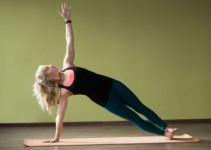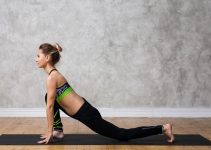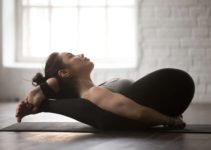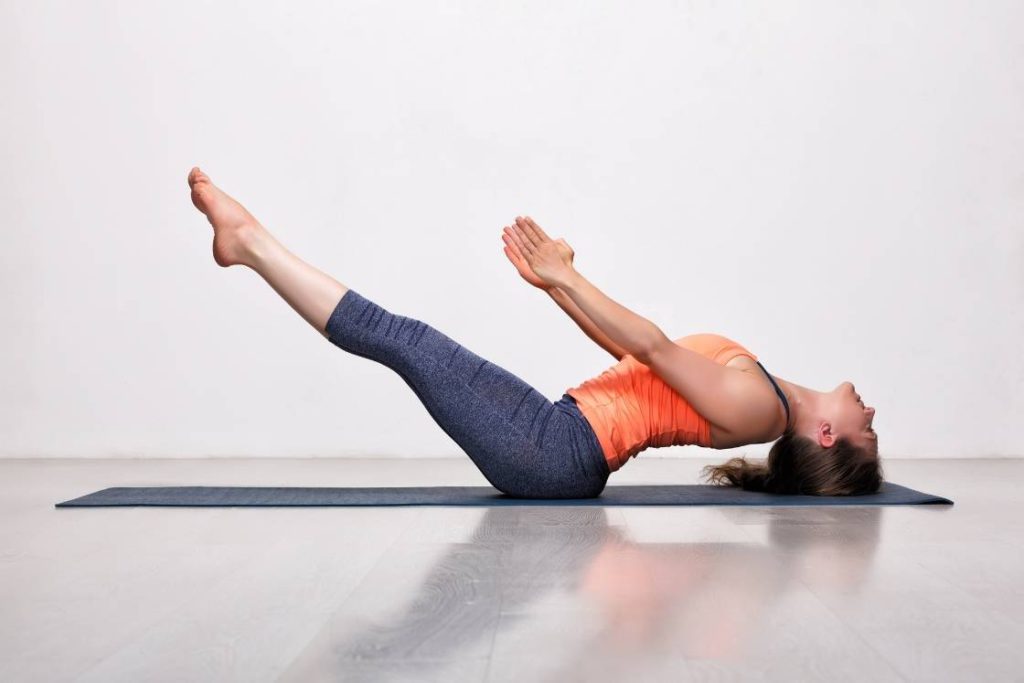
Uttana padasana is your go-to pose if you are craving to tone your flabby belly. It is a fusion pose of Matsyasana (fish pose) and legs raised pose.
To practice uttana padasana, lie down in the supine position arching the upper back. Lift the entire back to bend backward bringing the crown of the head to the floor. This is followed by raising the legs at 45 to 50 degrees from the floor. In the final pose, the arms are stretched parallel to the raised legs with hands joined in a prayer pose.
This pose is generally practiced as a counterpose after inverted restorative poses like Sarvangasana and Viprita Karani. However, the benefits of this posture are way too more than just relaxation of the body.
Uttana Padasana Meaning
There are three Sanskrit terms in uttana padasana. In Sanskrit “uttana” means “intense stretch” or “lying on the back with the face-up”, “pada” means “foot” or “leg”, and “asana” refers to “pose”.
While performing this pose, one lay down in supine position and then legs are lifted off the floor stretched intensely, hence the name. By combining the Sanskrit root terms this pose is termed as “raised leg pose“. Along with the legs, the arms are also stretched and lifted parallel to raised legs.
As both legs are raised in this pose, it’s also called “double leg raised yoga pose“. Remember, the legs in this pose remain tilted at an angle not perpendicular to the floor. The later position of legs is called by another pose “Urdhva Prasarita Padasana”.
Besides being an intense stretch to the limbs, it activates the back muscles. It is so because in the final posture the upper back and neck are lifted and forms an arch. The head is also inverted, hence this posture is a great stretch providing physical and mental benefits.
Practice Guide Uttana Padasana
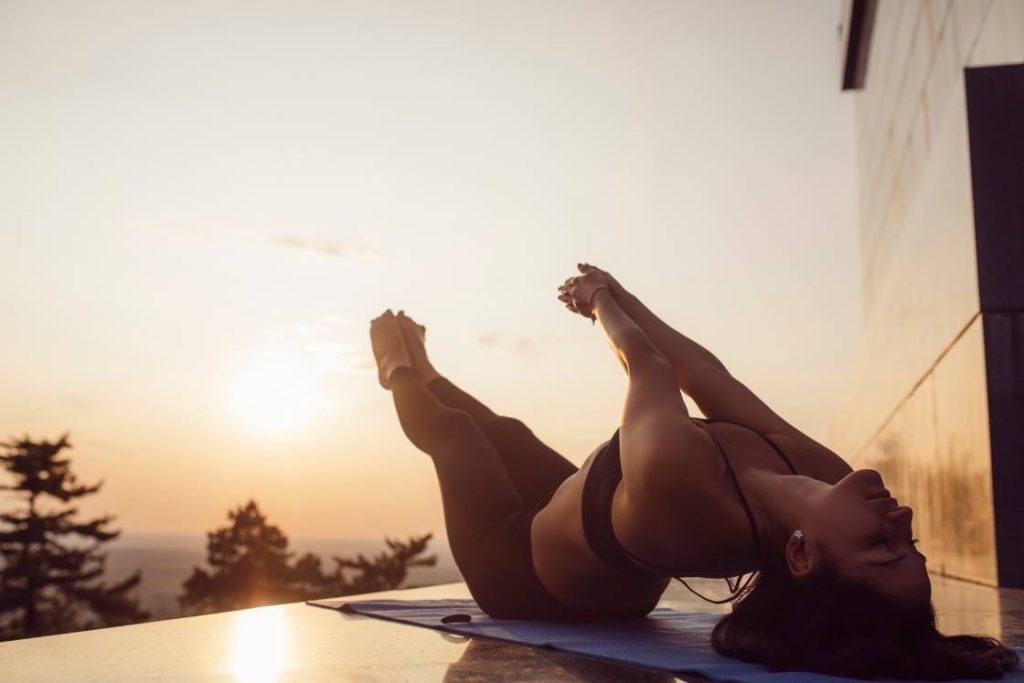
Contraindications
- Avoid this posture if there is any injury in the neck, back, pelvis, or leg muscles.
- Pregnant women must refrain from this pose.
- People suffering from severe spondylitis must ignore uttana padasana.
- Patients with cardiac diseases or abnormal blood pressure must refrain from this pose.
- If you have undergone hernia-repair surgery, wait at least two weeks before practicing this pose.
- If you have a migraine, then do not practice it with an aching back.
Preparatory Poses
- Single Leg Raised Pose (Eka Pada Uttanpadasana)
- Corpse pose (Shavasana)
- Fish Pose (Matsyasana)
Uttana Padasana Steps
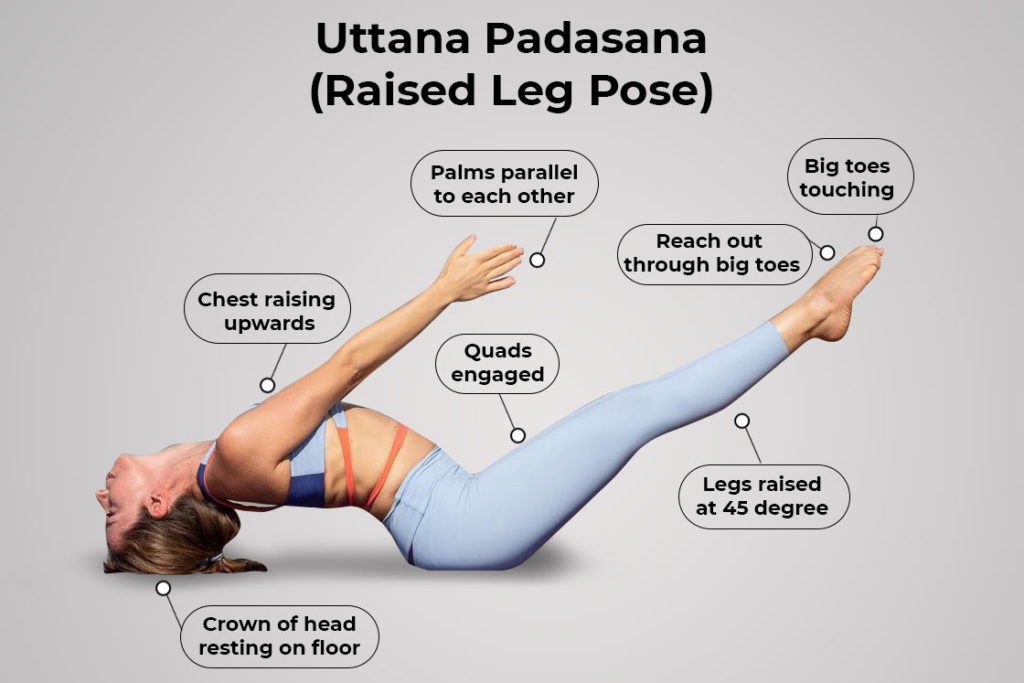
- Lie down on your back with legs and arms stretched on the floor.
- Flex your elbows to lift the back and arch your neck.
- Bring the crown of your head to the floor to perform the backbend.
- Inhale, raise your legs off the floor extending them to a 45° angle. The feet remain together while lifting and toes point towards the ceiling.
- Exhale, bring the arms forward joining the palms in a prayer pose.
- Stretch the arms parallel to the thighs.
- Balance the body on the crown of the head and hips.
- Hold the pose for about 6 breaths.
- Inhale bringing the arms down using the hands relax the head to the floor.
- Exhale bringing the legs to the floor and relax in a supine pose.
Precautions
- Do not bend the knees while the legs are raised in the air.
- Keep the buttocks firm on the ground.
- Do not collapse the front body while holding the final pose. Shift your weight forward engaging the core muscles to elongate the spine
Beginners’ tips
- If you are someone who is going to try this pose for the first time, begin with raising one leg at a time.
- Start with raising the legs to a lower angle and gradually increase it up to 45°.
- If back bending isn’t allowing you to raise the leg off the floor, use the props given below to support your back.
Follow-up Poses
Props and Modifications
- Blocks – Practitioners often use blocks instead of the bolster for this pose. Place a block horizontally under your thoracic spinal muscles and other vertically under your head. Then lift your legs and arms of the floor to perform uttana padasana.
- Bolsters – Place a bolster under your neck and one under the lower back. Then, perform the pose as described above. Using bolsters eases the lift and requires less strength to hold the pose with lifted legs.
- Against a wall – Lie down in supine pose and then arch the back and neck. Raise your legs and rest the feet on a wall. Then stretch the arms forward. The additional support from the wall helps in holding the pose for longer.
Variations
- Uttana padasana hand on floor variation – This is a common beginner variation that one can adopt to slowly build up core muscles.
Lie down on your back with hands to the sides. Lifting the legs off the floor bending at the hips to a 45° angle. Hold the pose as such. - Uttana padasana hands behind the head – In this variation, keep your hands tucked under the head lying in the supine pose. Then, lift the legs off the floor and keep the toe extended towards the ceiling.
Therapeutic Applications
- In the case of hernia, our abdominal muscles get weakened and part of an internal organ bulges out. Uttana padasana strengthens abdominal muscles and can prevent a hernia [efn_note] Dr’s Advice for Hernias https://yogainternational.com/article/view/drs-advice-for-hernias [/efn_note] from occurring in the first place
- This pose is also beneficial to spinal muscles and effective to cure back pain.
- It is performed by opening the chest and enhancing lung capacity. Hence, it improves breathing and is therapeutic to asthma and other respiratory diseases. [efn_note] Efficacy of Yoga Therapy in the Improvement of Lung Function Parameters http://indianyoga.org/wp-content/uploads/2017/04/vol-6-suppissue4.pdf [/efn_note]
- It improves the blood flow to the joints and strengthens them. This makes uttana padasana a healing pose to treat rheumatism.
- It can be practiced to cure the varicose veins in the legs.
- While holding the pose the head is placed in an inverted position. It improves the flow of blood and oxygen to the nerves and brain. Hence, it is a posture to alleviate stress, anxiety, and depression.
- It is a great stretch to the shoulders and chest. This is beneficial to correct the shoulder alignment, thus improves posture.
Uttana Padasana Benefits
1. Strengthens legs and hip muscles
Holding the pose with legs lifted in the air contracts and expands the leg muscles. It stretches the hamstrings, glutes, and calves.
The legs are lifted against gravity, this enhances the blood flow to legs and hips muscles and strengthens them.
2. Stretches the arms and shoulders
The arms are also kept lifted and stretched in front. It also enhances the blood circulation to the arms. It improves the strength of the arms, elbows, and shoulders.
3. Improves spine flexibility
The back is also lifted off the floor lengthening the spine and expanding the vertebrae. This exercises the back muscles and enhances spine flexibility.
4. Tones the abdomen
The core muscles are also exercised holding this pose. They are actively engaged to maintain the lift of the legs. It contracts the abdominal muscles and burns the extra fat from the abdomen.
As of a study in 2009, [efn_note] Management of Overweight and Obesity https://www.researchgate.net/profile/Yogesh_Deole2/publication/265026464_Management_of_Overweight [/efn_note] uttana padasana is an effective practice to reduce weight. It strengthens the abdominal muscles and tones the belly.
5. Stimulates reproductive organs
Uttana padmasana is practiced while lifting the legs. This engages the pelvic floor muscles and enhances the blood flow to the inner thighs, groins, and internal reproductive organs.
This activates the organs and improves their efficiency. Hence it can be practiced to uplift reproductive health.
6. Maintains metabolism
The neck muscles are stretched holding the pose. It stimulates the thyroid gland and improves the secretion of thyroid hormones. It regulates overall body metabolism and promotes health.
Conclusion
Performing uttana padasana benefits you in numerous ways as mentioned above. However, people prefer the pose as a workout to gain the abs and perfectly toned body.
Besides these, involve Uttana padasana into your routine to gain emotional and energetic benefits. It stimulates the Manipura, Muladhara, and Svadhisthana chakra and promotes emotional well-being, self-esteem, and confidence.
